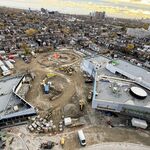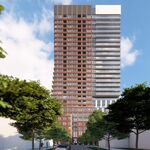Good luck finding a TTC logo in Durham Region or vice versa. That's the idea - that the T is a unifying thing, wherever you are in the GTHA, and whatever mode/agency you're looking for.
But problem is, the T doesn't convey information. If I see a big T on a pole, does that mean a bus stop, a subway station, or a GO station? Not until I walk closer to the sign and see the much smaller bus or train icon do I actually know what it is.
Say I'm at Main Street and Danforth Avenue, halfway between the subway station and the GO station, and there's a T on a pole at the subway station and a T on a pole at the GO station. Say my vision isn't good enough to make out the smaller stuff underneath the T, or I'm not familiar with the operators. So, which way do I go if I want to get to the subway? It's ambiguous. If the sign just had a big train icon and a big subway icon instead of the T, then I would know immediately.
If instead, there was just a big bus icon, that tells me, it's a bus stop. A set of icons, for example maybe a bus icon, an LRT icon, a subway icon, and a regional rail icon would be much better than the "T". This set of icons would be equally unifying - a bus icon in Toronto means a bus stop, a bus icon in Hamilton also means bus stop. It's also much more intuitive than the T - everyone knows that a bus icon means a bus stop, even people who don't speak English.
I really like Sydney's wayfinding. They don't use icons like I described, but they do something very similar with letters and colours representing modes. M in a turquoise circle for Metro, T in an orange circle for Trains, F in a green circle for ferries, B in a blue circle for buses, L in a red circle for LRT. The system is found everywhere in the Sydney area. Although letters are less universal than icons, they are simpler and more legible from a distance so they're still very good. The colours also make sure you can identify them from a distance.
That way when I see this:
I know immediately, "metro station"
Then this down the street:
I know immediately, bus stop.
And this:
Tells me instantly, a bus and LRT stop, buses on the left side of the platform, LRT on the right.
I also really like TfL wayfinding on paper, though they both don't implement as well as Sydney does - London's roundel is iconic and simple and conveys the mode whenever you see it. However, names of modes like "DLR", "TfL Rail", and "Elizabeth Line" aren't exactly intuitive as to what they actually are, and also National Rail is very confusing.




